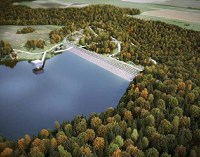Government struggle with drought
Why dams are not the solution
Although the priority in the combat of drought should be a reform of the agriculture, river tract, and landscape, the politics has stubbornly focused on dam constructions. The trouble is that in addition to safety risks and drastic environmental impacts, dams also cause unfair access to water and its redistribution.

What will return water back to the underground and to the rivers? This can be only done by environmental techniques aimed at retaining water in the environment. These simultaneously present a typical example of strategies that are fair to both people and water. In contrast, new dams are only a handy tunnel of the governmental cashbox.
Let’s solve the causes of drought
The governmental program to combat drought contains a number of good ideas. As an example, one key point is the need to increase water retention in the environment. However, it is impossible to agree with the idea that the majority of the measures put in place to combat drought revolve around the construction of megalomaniac dams costing billiards of crowns. This would, in the end, resulted in devastating curtailing of environmentalism in landscape architecture and sustainable farming since the necessary money are drowned in concrete. In addition to the repair of the river tract, renewal of marshlands, ponds, and polders, it is, first of all, also necessary to change the farming methods. This is related to the necessity of reducing the drainage of the landscape through soil amelioration everywhere possible. To dust off the idea of dams rejected for several decades is a bad joke. It does not solve the causes of drought; it is only a bad attempt at solving its consequences.
Even the general plan of surface water accumulation protected areas by the Ministry of Agriculture and Environment from 2011 states that the idea of dams should be considered to be the last resort, „after all other means of water accumulation are exhausted, when the impact of the climate change will not be possible to solve by other means, or when these will prove to be too expensive.“ Although this statement is included in the governmental material, it is not being utilized. Instead, the government hastily approves the construction of four new dams. The concrete lobby thus needs not to change anything about their plans (not only in the case of the Pěčín dam); it only accentuates a different purpose than in previous years and greens up its planning a bit.
In addition, government experts are suggesting an artificial infiltration of the river meadows with the help of well drills, which can result in a drastic reduction of the flow or even in pollution of the underground water. Another suggestion is the energetically-expensive pumping from the low to the upper river. Whatever happened to the common sense, environment, economy? The government expertise is based on a false premise that drought is only caused by climate change, considered to be an unmanageable global effect. But the global is always formed by the local. Therefore, the cause of a local drought is, indeed, a change of the global climate, but each and everyone of us bears their share of a local guilt. And so we can substantially reduce drought on the local scale and help to the improvement on the global scale.
What have we done to the landscape? We have killed the land by poor agriculture: vast fields, ploughing, chemicals in place of natural fertilizers, and constant use of heavier machinery. Dead soil retains little to no water. That is the true cause of drought. There is a constantly poor composition of plants in the woods (the spruce monocultures also do not retain much water), dried-up river meadows, rivers, and creeks destroyed by concrete. We have finished up grasslands and fields by drying them up through soil amelioration tubes, we have filled up marshlands, we unnecessarily saw down trees and have not replanted enough, we cover the landscape in tarmac and do too much construction on the „green meadow“ instead of utilizing old buildings and already-destroyed areas. Through all this we have destroyed the small water circulation in the landscape that had experienced rain nearly every day. The governmental experts do not count on the renewal of local rains, even though it is only a trivial
environmental multiplication fact. They claim that it is necessary to wait for rainfall (often torrential) from the sea.
Revolution in agriculture
The agricultural land can be our greatest „dam.“ Approximately 25% of the field and meadow area in the Czech Republic is drained through systematic drainage. That comprises over one million hectares of land that is continuously drained more than the rest of the land. This dramatically accelerates the draining of the entire land. Such a situation naturally brings about drought even without any climate change.
How much water can Czech agricultural land retain? Healthy land retains up to 400 liters per m2. The overall agricultural area is 4.3 million hectares. Let us not forget that in the Czech Republic one centimeter of land is formed for hundreds to thousands of years and one erosional event washes away up to several centimeters of land, resulting in a further reduction of the land’s retention ability. In vast areas in southern Moravia topsoil is already washed away and farmers only use soil forming substrate; i.e. the source from which land is formed.
Let us cautiously presuppose that a half of the Czech soil at the minimum is damaged by drainage, compaction, or both. Such land does not hold any water. If farmers corrected this, we gain 6 billion m3 of water at once. The largest reservoir Orlík comprises 716.5 million m³. Such a measure would thus manage to retain water volume of about 8.5 times greater than our greatest dam. The so frequently evoked valley reservoir Pěčín would fit into the volume 93 times.
A great added value would be healthy agriculture, increase in yields, healthy land, food, people and nature and more water evenly and fairly distributed across the country. It would also mean reduction in land warming since water cools land. The flow rate would increase, parameters of water purification would improve, there would be more water in wells, which would result in an increase in animal diversity and plants, and reduction of chemicals in the soil. Damaging impacts of floods would also be eliminated. Land erosion would be reduced to a minimum, as well as clogging of streams. (The combat against clogging of river streams also continuously drains the state budget). Let us assume that the major change will be non ploughing agriculture that uses to up 50% less oil and chemicals and results in up to 1/3 great yields. It also has great advantages when it comes to combating climate change.
What the government does not see
River meadow draining also hugely contribute to drought. We have turned parts of rivers into deep and wide draining canals made of concrete, and these constantly drain the surrounding river meadows and strengthen the intensity of floods. Artificially corrected rivers make up to 54 percent of the river tract and tirelessly create drought. Instead of new dams we need to revitalize river systems, i.e. return streams back to the state close to the nature as it will replenish great areas near rivers. Surprisingly, this is an old governmental program that lags by about hundred years due to administrative obstacles. This is also why there is currently drought.
How is it possible now that the governmental commission supposes that drought cannot be dealt with through other than technocratic means? Is it lobbyists that are behind this, or possibly absence of independent experts? Who will now remember that fifteen years ago the concrete lobby wanted 200 more dams? Following legitimate resistance of the public, environmentalists and mayors, the plan was reduced to „only“ 64 dams. The governmental analysis does contain the correct solution of drought, but the government does not see it. And so it currently intends to support the construction of four dams. The Pečín reservoir only will cost up to 11 billion CZK.
It is economically paradoxical that the necessary revolution in agriculture that includes renewal of soil plumpness and return of soil life would even save potentially resources. Along with return of rivers and their meadows to the natural state, we will reach water retention that is multiplicatively greater than would be achieved by the plans to build dams, and we will spend a lot less money. While doing this, we will not destroy any nature, buildings, or forests. On the other hand: we will renew a number of biotopes. Farmers could receive state relief for a suitable approach to the land since they would maintain a correct water regimen in the environment. Rivers, meadows, as well as agricultural land form a capital that society has completely missed. Following the principle that what is free is wasted. This concerns so called ecosystem services which include water retention. Their value practically cannot be enumerated.
One day we may be further. Then it will resemble the American Elwha River where they dismantle concrete embankments, and not only to renew salmon run. While it is true that one previous Czech government pledged – as part of unifying the procedure with the EU legislation – to remove all obstructions preventing migration by 2005, it now looks as though fish will continue to use elevators over embankments.
If we take climate change seriously, we cannot afford to build such vast reservoirs that produce one of the worst green house gases – methane. Future floodings often destroy forests and meadows that serve as priceless natural coolers. For this reason the government should always seek solutions that protect given matters of public interest. The construction of the Pěčín dam only conflicts with at least three Czech laws and EU’s system of nature protection. This will be similar for other dams as they slow down true system strategy that is advantageous not only for the nature and agriculture, but also people.
The author is an environmentalist and chair of Živá voda, an association founded in 2005 to accelerate return of water into the environment
Translated by Dagmar Frančíková.

